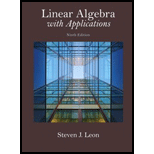
Determine whether the following are linear transformations from
(a)
(b)
(c)
(d)
Want to see the full answer?
Check out a sample textbook solution
Chapter 4 Solutions
Linear Algebra with Applications (9th Edition) (Featured Titles for Linear Algebra (Introductory))
Additional Math Textbook Solutions
University Calculus
Elementary & Intermediate Algebra
A First Course in Probability (10th Edition)
Elementary Statistics (13th Edition)
Basic College Mathematics
A Problem Solving Approach To Mathematics For Elementary School Teachers (13th Edition)
- Write a quadratic equation in factored form that has solutions of x = 2 and x = = -3/5 ○ a) (x-2)(5x + 3) = 0 ○ b) (x + 2)(3x-5) = 0 O c) (x + 2)(5x -3) = 0 ○ d) (x-2)(3x + 5) = 0arrow_forwardA vacant lot is being converted into a community garden. The garden and a walkway around its perimeter have an area of 690 square feet. Find the width of the walkway (x) if the garden measures 14 feet wide by 18 feet long. Write answer to 2 decimal places. (Write the number without units). Hint: add 2x to each of the garden dimensions of 14 x 18 feet to get the total area for the length multiplied by width.arrow_forwardSolve x-1 x+2 = 12 3 4 Your Answer: Answerarrow_forward
- Find the solutions to the following equation 21x²+5x=6 ○ a) -3/7, 3/2 ☐ b) -2/3, 3/7 ○ c) -7/3, 3/2 ○ d) -2/3, 7/3arrow_forwardListen Solve the quadratic equation. Write the one solution, do not write x =. 2 x²+6x+9= 0 বarrow_forwardSolve the rational equation 14 1 + x-6 x x-7 x-7 ○ a) x = 1, x = 8 ○ b) x = 1 ○ c) x = 7 ○ d) x = 1, x = 7arrow_forward
- Solve the absolute inequality | x + 5 > 3 ○ a) (-∞, -8] U[-2, ∞0) ☐ b) (-8, -2) c) (-2, ∞0) ○ d) (-∞, - 8) U(-2, ∞0)arrow_forward1) Listen Describe the error in the problem X 3 X x 3 - 2 = 25x = 0 25x 25 x = ±5arrow_forwardA falling object travels a distance given by the formula d = 6t + 7t² where d is in feet and t is the time in seconds. How many seconds will it take for the object to travel 115 feet? Round answer to 2 decimal places. (Write the number, not the units). Your Answer:arrow_forward
- Listen Solve the quadratic equation. Write the smaller answer first. 2 Xx - 5x = 24 x = Α x =arrow_forwardSolve the absolute equation |2x = 4| = 10 ○ a) x = -7, x = 3 ○ b) x = -2, x = 6 ○ c) x = -3, x = 7 ○ d) x = 7arrow_forwardFind a rational inequality that has the solution set (-2, 5] О a) x-5 x+2 b) x+5 x-2 ΛΙ ≥ 0 < 0 VI О c) x-5 x+2 ≤0 VI ○ d) x +2 x-5 <0arrow_forward
- Algebra & Trigonometry with Analytic GeometryAlgebraISBN:9781133382119Author:SwokowskiPublisher:Cengage
 Elementary Linear Algebra (MindTap Course List)AlgebraISBN:9781305658004Author:Ron LarsonPublisher:Cengage Learning
Elementary Linear Algebra (MindTap Course List)AlgebraISBN:9781305658004Author:Ron LarsonPublisher:Cengage Learning Linear Algebra: A Modern IntroductionAlgebraISBN:9781285463247Author:David PoolePublisher:Cengage Learning
Linear Algebra: A Modern IntroductionAlgebraISBN:9781285463247Author:David PoolePublisher:Cengage Learning


